15 Field Regiment received the Freedom of Entry to the City of Dandenong from the Mayor, Councillor K. A. Falconer, on 17 March 1962.
The following is the document signed by the Mayor, Councillor and Town Clerk and presented to the CO and members of 15 Fd Regt.

Thanks to Ray Dalli for providing additional information, including the following notice regarding the event:
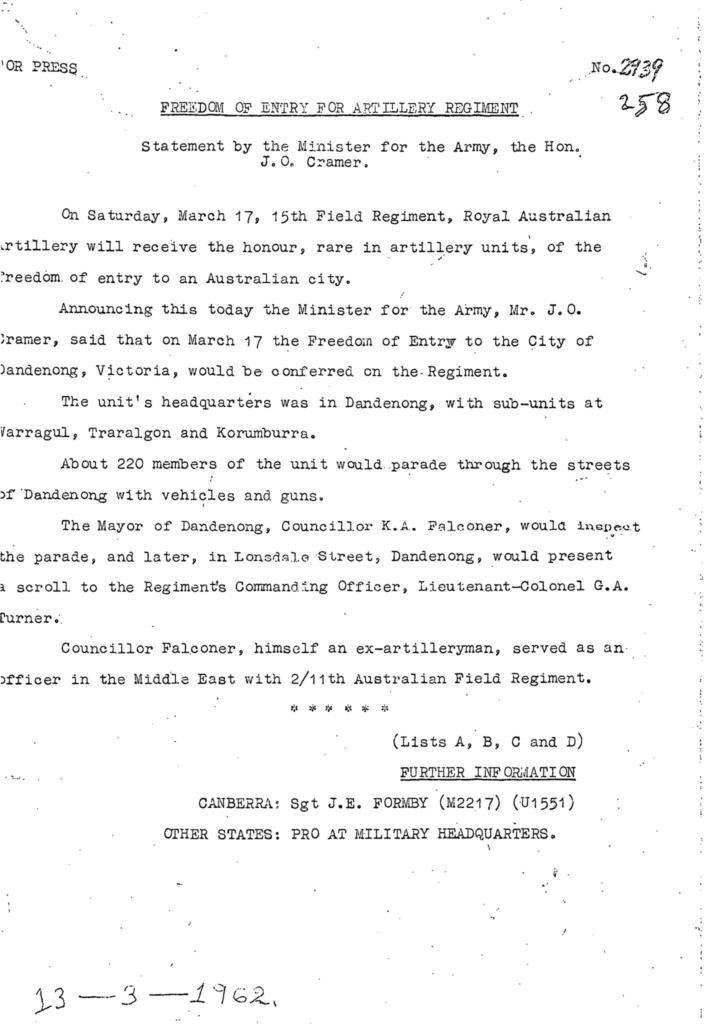
Note that 2/15 Fd Regt exercised this freedom in 1983 and again late in 1986 or early in 1987 (David Edwards was the Junior Subaltern on the second occasion and carried the Queens Banner).
Commemorative Key
A commemorative Key was presented to the Regiment on the occasion.
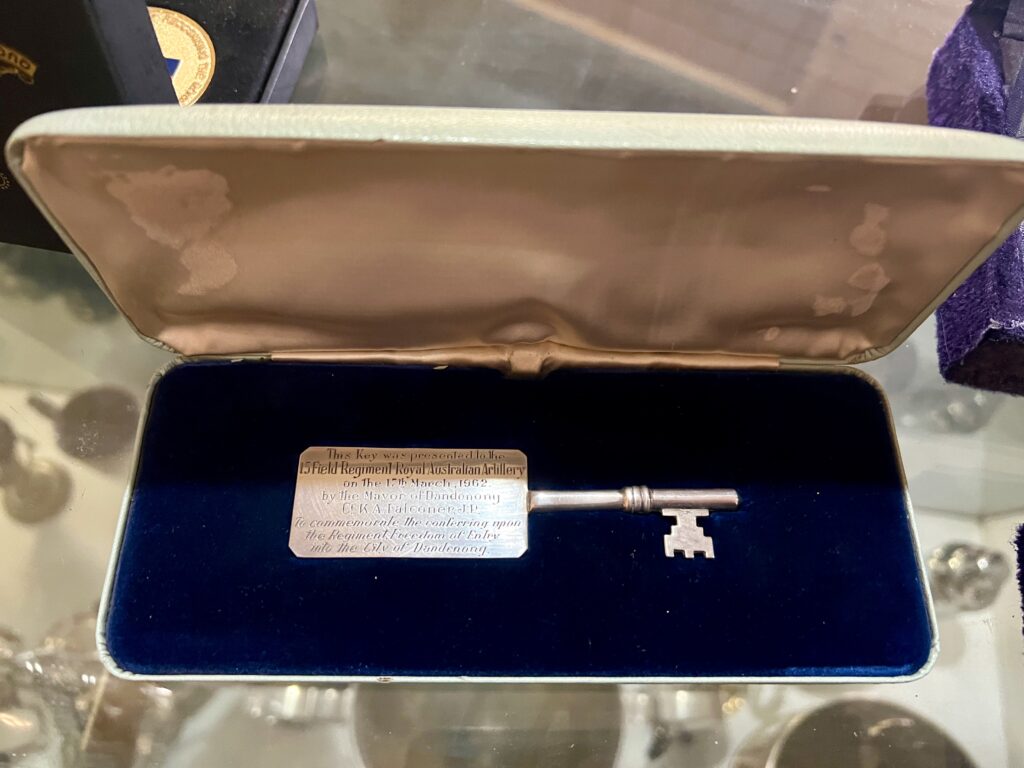

Both the framed document and key are on display at the RAA Association Memorabilia Room at the Chapel St. depot.
Freedom of Entry Photos
The photo gallery of the day (I believe the Salute photos are from another event).
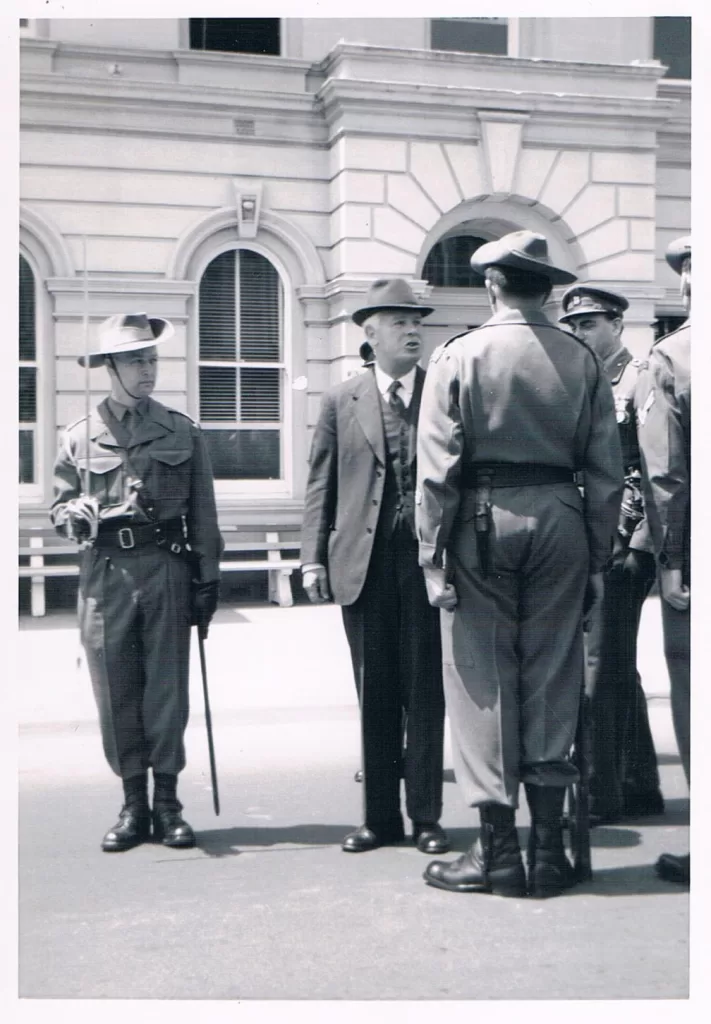

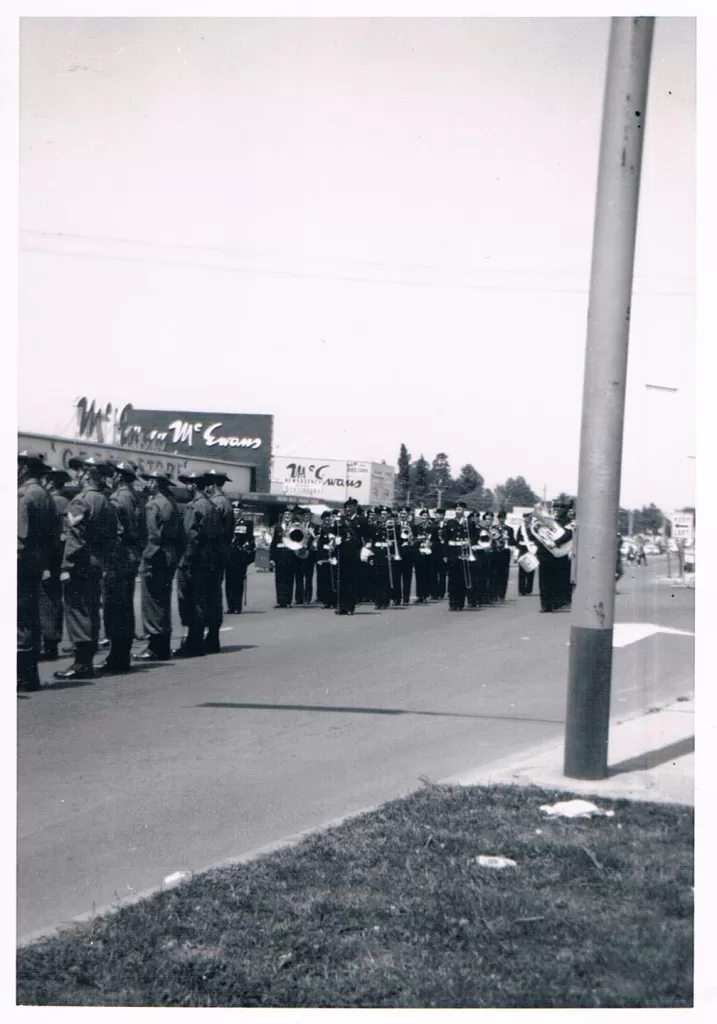
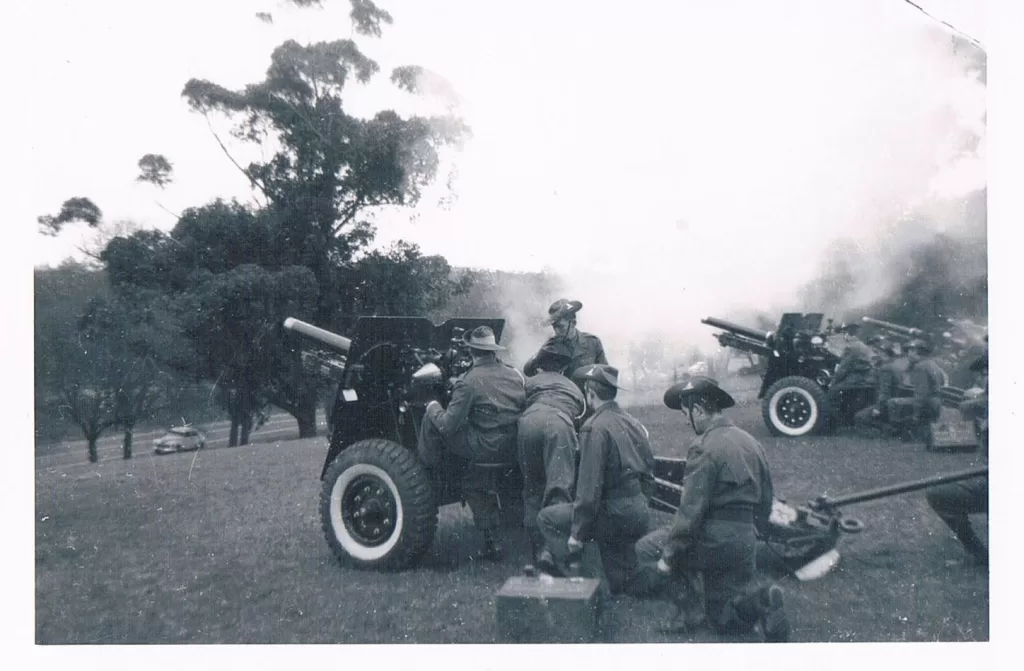
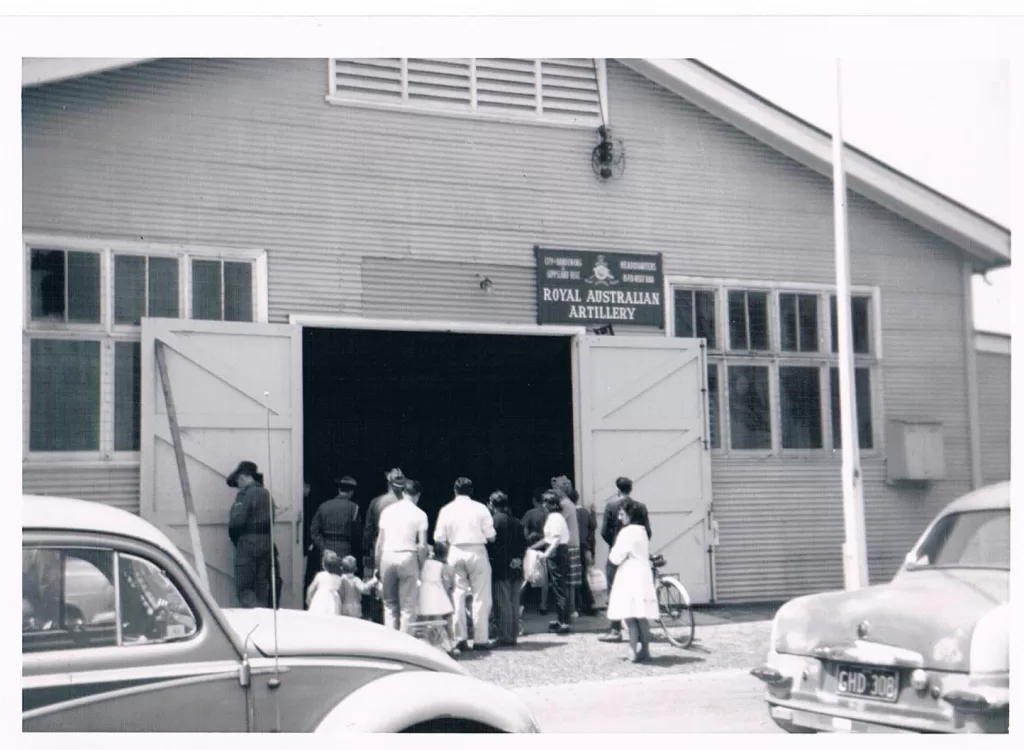
From Bill Severino who provided the photos:
The Freedom of the City of Dandenong consisted of a form up of 15 Field Regiment at the drill hall, a march to the Town Hall in Lonsdale Street, Dandenong and the customary ‘Challenge ‘ ceremony’.
This occurred some time in early 1963. I am shown side on in one of the photos.
The Reviewing Officer was Brigadier Vickery (not sure of his post-nominals), the Parade Commander was Major Jim Barry and shown on the left of the file in the photo of those Officers, with his back to the camera, is WO2 Mal Bugg.
The last photo in the set is of the 21 Gun Salute in The Domain on Queen’s Birthday, probably in the same year.
We also did a “Freedom of the City ” in Korumburra but I don’t think I have any photos of that.
Information on the Dandenong Drill Hall
Ray also provided the following information on the Dandenong Depot
Old Army Drill Hall, Princes Hwy, Dandenong, mid 2000s.
Dandenong Drill Hall, a timber-framed, corrugated iron clad building with iron roof and trusses built 1915-1916, was one of about forty timber and iron drill halls built in Victoria from 1912-1916. The building was comprised of a major hall space with a number of smaller rooms leading from the main hall including a kitchen, offices, storage room and mess rooms. The floors were of concrete in the hall with timber floors in the surrounding rooms. There were three small sheds at the rear of the hall and a large vehicle shed adjacent to the hall.
From as early as 1877 Dandenong had a volunteer corps, the Light Horse Troop and by 1888 The Victorian Rangers had a local unit at Dandenong of which eleven men served in Sth Africa in 1899. By 1913 the need for Dandenong to have a Drill Hall had become quite apparent as there were approx. 170 members of the different corps in training in the area. In July 1913 a Sergeant Manners MacFarlane advised in a memo the then Minister for Defense W.H. Irvine that suitable land could be excised from the Government reserve known as Dandenong Park. This purchase was gazetted on September 11th 1915, with the building being constructed and put to much needed use.
In 1938 substantial additions were made to the building including an Officers’ Mess, Sergeants’ Mess, Lecture room and a Cloak Room, followed by a private residence, a gun park and garages. All were much needed additions as Dandenong had recently become the headquarters of the new 52nd Battalion (the Gippsland Regiment) and required extra facilities, in particular mess facilities, for officers and other ranks, woo traveled long distances for functions, conferences, lectures and other activities. The hall was also used as a recruitment centre during WW1 and WW2.
In 1947 the hall was allocated to 5th Infantry Battalion as a depot for for the training of the Support Company, then in 1949 some minor alterations involving partitioning, new fireplaces and a Recreation room at the rear took place. In 1951 land adjacent to the Training Depot was acquired to garage 15 vehicles, then in 1957 the hall became the home of the 15th Field Regiment, Royal Australian Artillery, a 200 strong citizen military force unit.
The Drill Hall for the entirety of it’s existence was an integral part of Dandenong and surrounds both for military and socially. From its earliest days it was used as the venue for monthly community dances and other activities, for many years it even had the Dandenong Baths next to it. In 1945 the Dandenong Community Youth Centre moved there after having previously called the Pavilion at the Showgrounds (next to the Market) home. Between 1948-1954 the Scottish Regiment was proud to also call the Drill Hall home.
In the early years the regular drills could be used by many for keeping track of the time. With the loss of the regular gun shots, people lost interest, increasingly people relied on their own time pieces, leaving the Drill Hall to fade into memory along with its local architectural significance as an example of the many timber and iron drill halls built between 1912-1916.
Additional information from the local Dandenong paper on trying to save the drill hall.
DANDENONG war veterans say they are “greatly disappointed” at plans by the Greater Dandenong Council to demolish a 115-year-old army drill hall.
Residents and community groups will meet with council officers on Tuesday to discuss details of the Draft Dandenong Park Precinct Master Plan, which includes knocking down the drill hall and relocating Dandenong City Bowling Club and the neighbouring croquet club in order to make room for more parkland.
The plan is aimed at revamping Dandenong Park and transforming it into a hub of recreational activity.
But Dandenong World War II veteran and RSL member Bruce Patchell said the council’s plan to demolish the drill hall, built in 1890, would see the loss of important wartime history.
“I can understand the council not seeing its importance as we ex-service people do, for they fortunately may not have had to experience both World Wars and the Vietnam War,” he said.
Mr Patchell said the hall had served as a rally point for thousands of troops across south-east Melbourne during both World Wars.
“They signed their lives away in the drill hall in both the first and second World Wars, and the evidence from the loss of life in the area is exhibited in the honour roll board at Dandenong Town Hall,” he said.
Mr Patchell said the drill hall was in a neglected state but could be revamped into something useful.
But the veteran said he, the Dandenong RSL and its supporters would not stand for the historical building to be knocked down purely for more parkland.
“It is terribly important it be retained, so we can remember that many people of this city joined up and all signed their lives away,” Mr Patchell said.
“We did army training and drills there before we went to military camps.
“I’m for Dandenong and I have put some years of community work into this city, and am not prepared to stand by to see things flattened.”
Mr Patchell and fellow RSL members are expected to attend the 23 May meeting at Thomas Carroll Reserve, Crowe Pavilion, Box Street, Dandenong, at 6.30pm.